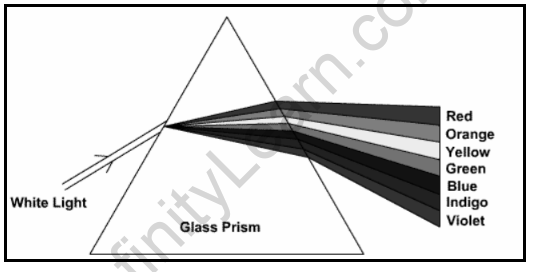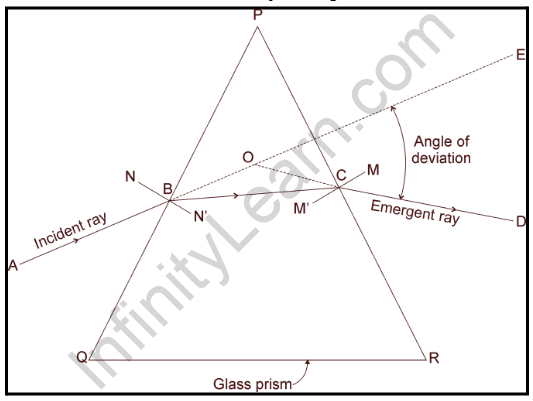Table of Contents
Introduction
Dispersion of light occurs when white light is broken down into its constituent hues as a result of refraction and Snell’s law. White light appears white because it contains every color in the visible spectrum. In non-vacuous materials, despite their close proximity, the index of refraction for each color is distinct. Each wavelength follows a different path as a result of these distinct indices. Light dispersion is the breaking down of white light into its constituent colors as a result of the refractive index of the surface and the wavelength of the light. The visible light spectrum was introduced and discussed in The Physics Classroom Tutorial’s Light and Color unit. Visible light, also known as white light, is made up of a variety of colors. These colors are frequently seen when light passes through a triangular prism. When white light passes through the prism, it is separated into its component colors, which are red, orange, yellow, green, blue, and violet. Dispersion is the separation of visible light into its various colors. It was mentioned in the Light and Color unit that each color is associated with a specific wave frequency, and that different frequency of light waves will bend differently when passing through a prism.
In this unit, we will look more closely at light dispersion, wondering why different frequencies of light bend or refract differently when they pass through a prism. The optical densities of different materials distinguish them from one another. The optical density is simply a measure of a material’s ability to slow light as it passes through it. As previously stated, a light wave passing through a transparent material interacts with its atoms. When a light wave strikes a material atom, it is absorbed by that atom. The electrons in the atom vibrate as a result of the absorbed energy. If the frequency of the light wave does not match the resonance frequency of the vibrating electrons, the light will be re-emitted by the atom at the same frequency with which it impinged. After that, the light wave travels to the next material atom through the interatomic vacuum. The process of absorption and re-emission is repeated when it collides with the next atom. The optical density of a material is the result of the atoms’ tendency to retain the absorbed energy of a light wave as vibrating electrons before remitting it as a new electromagnetic disturbance.
Thus, while a light wave travels through a vacuum at c 3.00×108m/s it travels at speeds less than c through a transparent material. The index of refraction value (n) expresses the optical density of a given medium quantitatively. Materials with higher indexes of refraction tend to retain absorbed light energy for longer periods of time before re-emitting it to the interatomic void.
Overview
When light is transmitted to a prism, dispersion occurs, which is defined as the separation of white light into different colors. The scattering of light is proportional to the length of the light. As a result, it is possible to argue that the degree of deviation is determined by the wavelengths. The length of a deviation from the light path is the inverse of the standard length. White light is primarily associated with the light of various wavelengths (colors). Violet, indigo, blue, green, yellow, and red have extremely long lengths, whereas violet has an extremely short length. White light is split into seven basic colors when it passes through a prism. A prism is a transparent optical element that refracts light and has flat, polished surfaces. Refraction of light refers to the change in the direction of propagation of light when it passes through a different medium.
The diagram depicts the dispersion of light waves by a prism.

So, in order to clarify whether a prism created light or separated it, Sir Isaac Newton conducted an experiment that permanently resolved all doubts. He took two prisms and placed them next to each other, with the first one upright and the second inverted. He allowed a beam of white light to pass through one prism and fall through the second. The first prism separated the color components of white light, while the inverted prism combined them into white light. As a result, after passing through both prisms, the final emerging beam was white light. As a result, it was demonstrated that white light already consists of seven colors.
The angle of refraction causes the dispersion of white light. The process of refraction can be defined as the blending of light as it passes from one medium to another. When light passes through a glass prism, it deviates twice: once when it enters the prism and again when it exits. Because all of the colors have different wavelengths and are refracted at different frequencies and angles, the violet color blends the best and the red color the least.
Refraction and dispersion of light through a prism
Prism is merely a medium for the dispersion of light composed of seven colors. When light strikes the prism, it refracts. The wavelength and frequency of these deviated colors differ; they deviate at different angles due to the prism’s velocity difference. When light travels from one medium to another, the speed at which it travels changes, and as a result, it ‘bends’ or is refracted.’ When light passes through a prism, it is refracted towards the triangle’s base.
The wavelengths of the various colors in the light spectrum are different. As a result, the rate at which they all bend varies depending on the wavelength, with violet bending the most because it has the shortest wavelength and red bending the least because it has the longest. As a result, when white light is refracted through a prism, it disperses into its color spectrum.
Refraction is the bending of light’s path as it travels from one medium to another. The degree of refraction is determined by the wavelength of the light. Each light wave has a different wavelength and thus deviates in a different way. White light is made up of different wavelengths (colors) of light, such as violet, indigo, blue, green, yellow, and red. Red has the longest wavelength, while violet has the shortest.
Refraction of light through a prism
The direction of light changes when it passes from one medium to another. Light, in other words, bends as it moves from one medium to another. This is referred to as refraction. Light waves are refracted as they travel from one optical medium to another due to the difference in optical density between the two. The degree of refraction varies with light wavelength. The refractive index of a medium affects the speed of light in different media.

Prism Angle: A glass prism has two triangular bases and three rectangular lateral surfaces that are inclined at an angle known as the prism angle. On its base QR, a glass prism PQR has been kept. A ray of light AB is incident on the prism’s faces PQ.
AB is an incident ray in this case. When a light ray passes through a prism, it bends towards the prism’s base. Because the incident ray AB is travelling from the air (rare medium) into the glass (denser medium), it bends towards the normal BN’ and travels along the direction BC inside the glass prism. Thus, BC is the refracted ray of light that bends towards the prism’s base QR.
Refraction through prism
The bending of light as it travels from one medium to another is known as refraction. For example, when a ray of light passes through a glass prism, refraction occurs both when it enters and when it exits the prism. Because the refracting surfaces are not parallel, the emergent ray and incident ray are not parallel. In this case, the light ray deviates after passing through the prism. A transparent object with two triangular ends and three rectangular sides is known as a glass prism. The refraction of light in a glass prism differs from that of a glass slab. This is because the incident ray of light in a glass prism is not parallel to the emergent ray of light. When a light ray enters the glass prism, it deviates twice. The first is when it enters the glass prism, and the second is when it exits the prism. This is due to the prism’s refracting surfaces not being parallel to each other. In addition, when a light ray passes through a prism, it bends towards the prism’s base.
Light passing through the prism
A transparent object with two triangular ends and three rectangular sides is known as a glass prism. Light is made up of many different colors with different wavelengths. A light ray deviates from its path only when the medium of propagation changes and white light travels in a straight line. As a result, the various colors that comprise light become separated. This is because each color has its own wavelength that bends at a different angle. Prism merely acts as a conduit for light dispersion in the seven primary colors. Refraction occurs when light strikes the prism. These deviated colors have different wavelengths and frequencies, and they deviate at different angles due to the velocity difference of the prism.
A light beam is refracted both inside and outside a glass prism as it passes through it. Because the refracting surfaces are not parallel, the emergent and incident rays are not parallel. In this case, a light beam deviates as it passes through a prism. As it passes through the prism, light is separated into its component colours of red, orange, yellow, green, blue, and violet. The division of visible light into its various colours is known as dispersion.
Crack NEET with Result-Oriented Learning Program from Infinity Learn
FAQs
Question: Give some examples of light dispersion.
Answer: Examples of light dispersion are provided below.
- Morning dewdrops in the winter
- Rainbow formation
- The Compact Disc (CD)
- Diamond
Question: What Is the Difference Between Light Dispersion and Light Refraction?
Answer: The primary distinction between refraction and dispersion of light is given below:
As previously stated, refraction is any bending of waves caused by a change in speed. Refraction occurs when water waves travel through a range of depths and heights. Dispersion, on the other hand, is frequency-dependent, and when we say that light is refracted by a prism, dispersion here means that there will be a higher frequency of bending of light. As a result, refraction is the bending of light, whereas dispersion is the frequency dependence of light characteristics.
Infinity Learn App
Now you can find answers to all your subject queries & prepare for your Exams on our Best Learning App – Infinity Learn.









